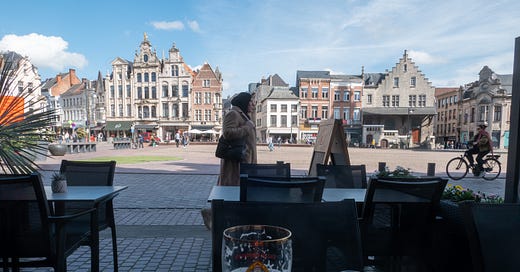(Prior to this, I walked from Amsterdam to Rotterdam, before taking a train to Antwerp. From Antwerp I walked to Lier, then to Mechelen, then to Brussels, where I stayed for three days1. I have more pieces to write about the whole trip, once I get home.)
Antwerp quickly reveals itself to be very different from the Netherlands, despite being an hour away by train, and despite speaking effectively the same language. It has a looser, less bureaucratic, more animated and yet more relaxed feel, that’s also reflected in the architecture. While Antwerp has the same story-book style downtown, gone are the overly regulated outskirts of varied repetition, the monotonous bland housing developments, replaced with a mix that leans towards a historic townhouse look, even if only an inexpensive facade.
There is more variation in everything, including the shops, restaurants, cafes, and bars, which, unlike in the Netherlands, are not confined to downtowns or high streets.
On my first morning in Antwerp, after nine days of walking across Netherlands, I felt giddy, like I’d escaped from a long dull, but very polite, party, and with nothing to do until I could check into my hotel, I drank too much, drawn into cafes stuffed with happy families, that served more than just Heineken. Real beer, around real people, so I told myself.
First impressions can be dangerous, but after sixty miles walked, I stand by them. Belgium, at least the part between Antwerp and Brussels is surprisingly different from the Netherlands. Everything, including the people, is more relaxed, more spontaneous, and less the same. Given how close they are, I’m not sure why.
Figuring out exactly why became one of the things I thought about while walking, when I wasn’t too focused on not being hit by a cyclist2.




